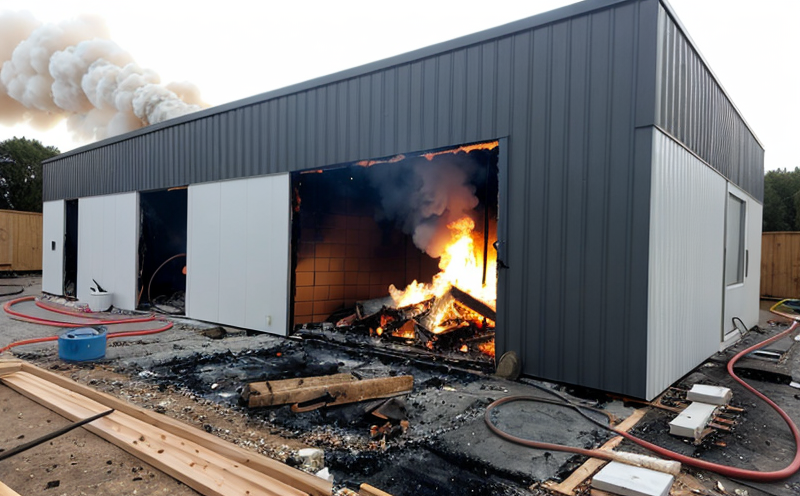Surface Flammability Testing of Insulation Sheets
In fire safety testing, understanding and ensuring the flammability characteristics of insulation materials is crucial. This is particularly important in sectors such as construction where the use of cladding and insulation can significantly impact fire spread within buildings. Surface flammability testing evaluates how materials behave under specific conditions to determine their resistance to ignition. This service focuses on the surface flammability testing of insulation sheets, which are critical components in many building constructions.
The test is conducted using internationally recognized standards such as ISO 6947 and ASTM E648, ensuring that the results are reliable and comparable across different regions. The process involves placing a standard-sized specimen on a surface where it is exposed to a flame source for a specific duration. The time taken for the material to ignite, burn, or extinguish itself after the flame removal is measured.
The testing procedure ensures that any insulation sheet used in construction adheres to strict fire safety regulations and guidelines set by relevant authorities. This not only protects public health but also ensures compliance with building codes and standards, thus reducing potential risks associated with fires in buildings.
Surface flammability tests are particularly important for materials such as mineral wool, polystyrene foam boards, polyurethane foam boards, and other similar insulation materials used in cladding systems. These materials play a vital role in the overall fire safety of a building by providing thermal insulation while potentially acting as fuel sources if not properly tested and selected.
The tests are conducted under controlled laboratory conditions to ensure accuracy and repeatability. The specimens are prepared according to the specified dimensions outlined in the relevant standards, ensuring that each test is comparable and consistent. The testing apparatus includes a standard burner and an arrangement for measuring time durations accurately.
Understanding the results of these tests helps designers and engineers make informed decisions about material selection, thereby improving fire safety performance. For instance, if a particular insulation sheet fails to meet the required standards, alternative materials or modifications can be considered early in the design process. This proactive approach ensures that any potential issues are identified and addressed before they become critical problems.
The importance of this test cannot be overstated, especially considering recent high-profile fire incidents where building cladding contributed significantly to rapid spread of fires. By adhering to strict testing protocols and standards, we can help prevent such tragedies in the future.
- Mineral Wool: A common insulation material known for its thermal and acoustic properties.
- Polyurethane Foam Boards: Often used due to their high insulating value but require stringent flammability testing.
- Polystyrene Foam Boards: Commonly used in construction, they need thorough examination to ensure they do not contribute to fire spread.
- PVC Foam Sheets: Another insulation material that must pass rigorous flame retardant tests.
The detailed results of these tests are provided in a comprehensive report. This includes the time taken for ignition, burn duration, and self-extinguishing time after removing the flame source. These data points help stakeholders understand how the materials perform under specified conditions, aiding in better decision-making processes regarding material selection.
Scope and Methodology
The scope of surface flammability testing includes evaluating the ignition behavior, burn time, and self-extinguishing capability of insulation sheets. This service strictly adheres to international standards such as ISO 6947 and ASTM E648 to ensure accuracy and consistency in results.
The methodology involves preparing a standard-sized specimen according to specified dimensions outlined in the relevant standards. The specimen is then placed on a surface where it is exposed to a controlled flame source for a predetermined period. Time measurements are taken from when the flame touches the sample until self-extinguishment occurs after removing the flame.
The testing apparatus used includes a standard burner and an arrangement for precise timing, ensuring that each test follows strict protocols. This helps in achieving reliable and repeatable results which are crucial for compliance with fire safety regulations.
Post-testing, detailed reports are generated that provide insights into the ignition time, burn duration, and self-extinguishing behavior of the insulation sheets. These reports serve as valuable tools for stakeholders to make informed decisions about material selection and application in construction projects.
Industry Applications
The surface flammability testing service finds applications across various sectors including construction, manufacturing, and safety equipment. In the construction industry, this test is essential for ensuring that insulation materials used in cladding systems comply with fire safety regulations. This helps prevent incidents like those seen in Grenfell Tower where building cladding played a significant role in rapid fire spread.
Manufacturers of insulation materials benefit greatly from this service as it provides them with detailed insights into the flammability characteristics of their products. They can use these data points to improve product design and manufacturing processes, ensuring that they meet or exceed stringent fire safety standards.
Safety equipment manufacturers also rely on this testing service to ensure that the materials used in their products do not pose any additional fire hazards. By adhering to strict testing protocols, they contribute towards enhancing public safety by providing reliable and safe products.





